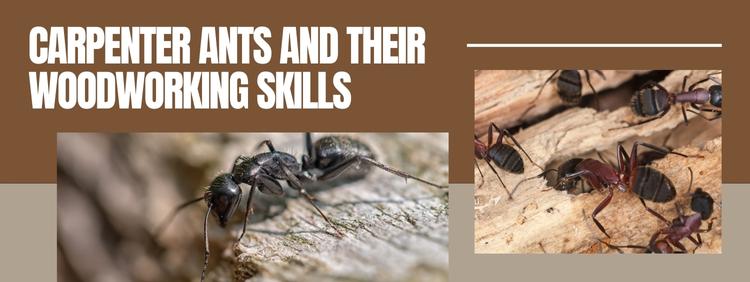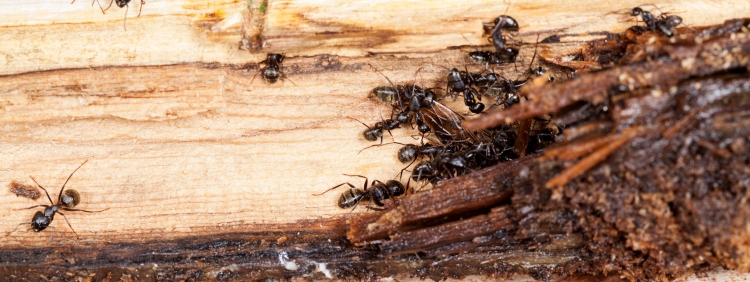Toronto Pest Control: Unveiling the Truth About Carpenter Ants and Their Woodworking Skills

Have you ever paused to wonder at the masterful mazes that carpenter ants carve within wood structures? They are indeed a formidable force of nature.
Carpenter ants, although primarily wood dwellers, can infiltrate your homes, causing significant structural damage. They do not eat wood but chew through it to create elaborate tunnels for nesting. If you find sawdust-like trails around your property or hear a faint rustling inside your walls, you might be dealing with a pest infestation.
Yet, while their woodworking prowess is impressive, it can prove destructive to your home or property. Welcome to our blog, where we will be unveiling the truth about these diligent insects and their woodworking skills. We will also discuss how to get rid of ants and why Truly Nolen Canada is your go-to solution for carpenter ant removal in Toronto.
What Are The Characteristics And Behaviours Of Carpenter Ants?
Often mistaken for termites due to their affinity for wood, carpenter ants are unique creatures with remarkable woodworking skills. But unlike termites, they don’t feed on wood. Instead, they create intricate networks of galleries and tunnels, essentially turning your home’s wooden structures into a large nest.
Carpenter ants are typically black, red, or a combination of the two and can vary significantly in size. The workers responsible for most of the woodworking can range from 1/4 to 1/2 inch in length. The queen, on the other hand, is the largest member of the colony and can reach up to one inch long.
Witnessing Carpenter Ants at Work
Their woodworking isn’t meant to harm or destroy your property. Carpenter ants are just looking for a suitable home. However, their ‘home-seeking’ behaviours can damage your property considerably. Here’s a hint: If you notice small, smooth holes in your wooden materials accompanied by piles of sawdust (which is, in fact, an ant-produced wood dust called frass), it’s a sign that they have made themselves at home.
Carpenter ants are not simply pests but skilled excavators turning your wood into intricate labyrinths. However, their creativity becomes a serious problem when it comes to your home.
Spotting an Infestation: The Warning Signs
- Sawdust: As carpenter ants tunnel through wood, they create sawdust-like debris referred to as ‘frass.’ Finding these tiny mounds could hint towards an infestation. This frass is often found near the openings of the nests. Therefore, spotting these accumulations in usual places could be your first sign of an invasion. Additionally, ant pathways or distinct patterns of movement around your home might materialize. Pay close attention during nighttime, as the busy critters are primarily nocturnal, furthering their craft after the sun sets. Understanding these signs allows for timely intervention and pest removal.
- Rustling Sounds: In a quiet environment, you might hear faint, rustling noises coming from your walls or wooden structures. That’s the sound of these little carpenters at work. This is particularly noticeable at night when the rest of your household is quiet. Those soft rustling sounds are echoes of the ants burrowing their way through the wood, crafting intricate tunnels. Over time, these tunnels can compromise the structural integrity of the wood, making early detection and removal critical.
- Ant Activity: Seeing a few ants around is nothing to panic about. However, frequent sightings, especially of large, winged ants, indicate a likely nest somewhere close. If these winged ants are visibly indoors, it is often a clear sign of an infestation nearby. These large ants are actually winged reproductives, also known as alates, who leave the nest to start a new colony elsewhere. Keep an eye on their activity as it will give you clues about where the nest might be.
- Wood Damage: Unexplained damage to wooden structures, like hollow-sounding spots or smooth tunnels through the wood’s surface, should ring alarm bells. These symptoms often indicate the presence of carpenter ants working diligently behind the scenes. They are skilled craftsmen of sorts, chewing through wood and creating intricate tunnel systems within. They favour damp wood because it’s easier to excavate, which is why infestations are often found in rotting decks, window sills, or other moist timber areas around the home.
How Do Carpenter Ants Cause Damage To Wood?

Let’s delve into the heart of the matter: the astonishing woodwork of carpenter ants. It’s essential to understand that they do not eat wood, unlike termites. Instead, they meticulously carve it out to construct their nests. So, how do they accomplish this?
Ants’ Remarkable Woodworking Ability
Carpenter ants are nature’s gifted architects. They use their robust mandibles, the jaw-like appendages at the front of an ant’s head, to gnaw and remove small amounts of wood to craft their homes. The tunnels they shape inside the wood are incredibly smooth, demonstrating a level of precision that is awe-inspiring. Ants work tirelessly, embodying the well-known proverb – ‘little drops of water make the mighty ocean.’ They remove tiny fragments of wood day in and day out, creating extensive networks of tunnels and galleries inside the wood.
Often, homeowners may marvel, even reluctantly, at the profound skills of these tiny creatures. The encounter is simply compelling when you see the ants at work. They move with swift coordination, each one playing its part in the larger goal of the colony. The unity and precision they exhibit are remarkable, a testimony to their industrious nature and inherent instincts.
Carpenter ants seamlessly merge their hard work with a natural acuity for spatial understanding, turning the simple action of burrowing through wood into an art form. This ability to carve perfect homes within the wood structure is nothing short of amazing. However, their commendable skills aside, a carpenter ant infestation is not a pleasant experience for homeowners.
Recognizing an ant infestation is not always straightforward. These ants are sneaky infiltrators, often hiding away deep within the wooden structures of your home until they’ve made substantial progress in their woodworking. Evidence of an infestation may include small piles of sawdust-like material, known as frass, underneath wooden items. Listening closely may also reveal the faint rustling sound of ants working within the walls. Another tell-tale sign to look out for is the presence of winged ants emerging from ceilings, walls, and other hidden crevices, especially during spring. Identifying and addressing infestations quickly is crucial to prevent further structural damage to your property.
The Chaotic Order of Their Destruction
But this natural marvel has a downside for homeowners. While their ability to whittle away wood is fascinating from a biological standpoint, it can cause significant structural damage over time. The compounding effect of several colonies can weaken and compromise the integrity of a structure, leading to expensive repairs.
Infested wood usually looks clean and smooth inside. However, outside you may find their sawdust-like substance that is a mixture of wood particles, dead ants, and excrement which the worker ants remove from the nest. This often piles up near the openings of the tunnels, hinting at the hidden chaos within.
Observing a carpenter ant in action goes beyond witnessing merely an intruder in your space. Think of them as miniature crafters, diligently chipping away at your wood structures with their jaws. Picture their tiny mandibles working methodically, extracting each wood particle to reconstruct their labyrinthine network. The transformation, however eye-catching, wreaks an unwelcome change in your wood assets which can possibly turn into a full-blown infestation over time.
Understanding Their Preference
Carpenter ants are not too fussy about the type of wood they go for when it comes to home construction. They can set up shop in any wood, but they seem to prefer moist wood. This includes decaying trees, stacked firewood, or parts of homes that have suffered water damage. Knowing this, homeowners can take preventive measures to ensure they don’t inadvertently create the perfect living conditions for these tenacious ants.
As interesting as it may be to observe this particular ant species, it, unfortunately, comes with a significant downside. Their work is a destructive practice that can prove costly if it occurs on your property.
It’s essential to be aware that an infestation is not always immediately apparent. These ants are nocturnal and do much of their work unseen, under the cover of darkness. During the day, their activities often go unnoticed, as they remain hidden within their nests. But their woodworking leaves signs. Besides frass, other indicators of an infestation include faint rustling noises within the walls and other wood structures, especially during the quiet nighttime hours.
The Perfect Solution: Truly Nolen Pest Control
When dealing with carpenter ants, time is of the essence. Any delay can lead to more significant damage. Pondering over the vital question of ‘how to get rid of ants?’ Worry not, Truly Nolen pest control services in Toronto is the right choice. They have the expertise, tools, knowledge, and commitment to effectively tackle the problem of carpenter ants. They understand that pest removal in Toronto needs a comprehensive approach.
So, when you see signs of a potential infestation or for preventive measures, don’t hesitate. Contact Truly Nolen Canada. Our approachable team is ready to help. Remember, prevention is always better than cure; the key to this is knowledge and timely action.
Contact us to learn more about how we can help maintain your home and keep it ant-free with our Four Seasons approach!